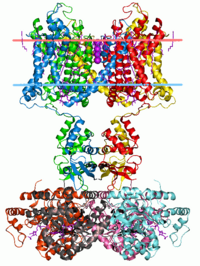
Photo from wikipedia
AIMS Macrophages (MΦ), known for immunological roles such as phagocytosis and antigen presentation, have been found to electrotonically couple to cardiomyocytes (CM) of the atrio-ventricular node via Cx43, affecting cardiac… Click to show full abstract
AIMS Macrophages (MΦ), known for immunological roles such as phagocytosis and antigen presentation, have been found to electrotonically couple to cardiomyocytes (CM) of the atrio-ventricular node via Cx43, affecting cardiac conduction in isolated mouse hearts. Here, we characterise passive and active electrophysiological properties of murine cardiac resident MΦ, and model their potential electrophysiological relevance for CM. METHODS AND RESULTS We combined classic electrophysiological approaches with 3 D florescence imaging, RNA-sequencing, pharmacological interventions and computer simulations. We used Cx3cr1eYFP/+ mice wherein cardiac MΦ were fluorescently labelled. FACS-purified fluorescent MΦ from mouse hearts were studied by whole-cell patch-clamp. MΦ electrophysiological properties include: membrane resistance 2.2 ± 0.1 GΩ (all data mean±SEM), capacitance 18.3 ± 0.1 pF, resting membrane potential -39.6 ± 0.3 mV, and several voltage-activated, outward or inwardly-rectifying potassium currents. Using ion channel blockers (barium, TEA, 4-AP, margatoxin, XEN-D0103, DIDS), flow cytometry, immuno-staining and RNA-sequencing, we identified Kv1.3, Kv1.5 and Kir2.1 as channels contributing to observed ion currents. MΦ displayed four patterns for outward and two for inward-rectifier potassium currents. Additionally, MΦ showed surface expression of Cx43, a prerequisite for homo- and/or heterotypic electrotonic coupling. Experimental results fed into development of an original computational model to describe cardiac MΦ electrophysiology. Computer simulations to quantitatively assess plausible effects of MΦ on electrotonically coupled CM showed that MΦ can depolarise resting CM, shorten early and prolong late action potential duration, with effects depending on coupling strength and individual MΦ electrophysiological properties, in particular resting membrane potential and presence/absence of Kir2.1. CONCLUSIONS Our results provide a first electrophysiological characterisation of cardiac resident MΦ, and a computational model to quantitatively explore their relevance in the heterocellular heart. Future work will be focussed at distinguishing electrophysiological effects of MΦ-CM coupling on both cell types during steady-state and in patho-physiological remodelling, when immune cells change their phenotype, proliferate, and/or invade from external sources. TRANSLATIONAL PERSPECTIVE Cardiac tissue contains resident macrophages (MΦ) which, beyond immunological and housekeeping roles, have been found to electrotonically couple via connexins to cardiomyocytes (CM), stabilising atrio-ventricular conduction at high excitation rates. Here, we characterise structure and electrophysiological function of murine cardiac MΦ and provide a computational model to quantitatively probe the potential relevance of MΦ-CM coupling for cardiac electrophysiology. We find that MΦ are unlikely to have major electrophysiological effects in normal tissue, where they would hasten early and slow late CM-repolarisation. Further work will address potential arrhythmogenicity of MΦ in patho-physiologically remodelled tissue containing elevated MΦ-numbers, incl. non-resident recruited cells.
Journal Title: Cardiovascular research
Year Published: 2021
Link to full text (if available)
Share on Social Media: Sign Up to like & get
recommendations!